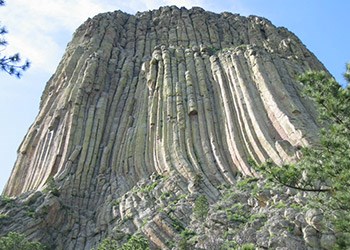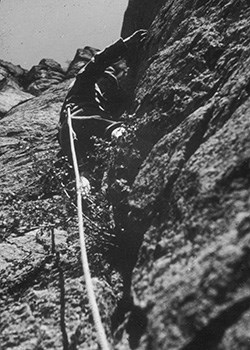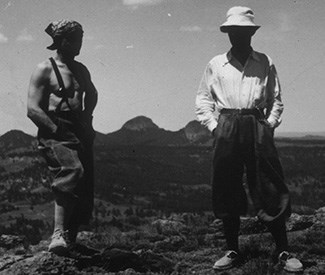
NPS photo On a bleary day in the plains of eastern Wyoming, a small group of travelers decides to take a detour to a place known as Devils Tower. The group was returning to New York City and had planned a stop-over in the Black Hills for one of their favorite past times: rock climbing. Most of the group was skeptical about the detour, since Devils Tower was not a place for rock climbing. As Fritz Wiessner stood at the base of Devils Tower, gazing up at its monumental columns, he thought to himself this would be a good place to climb. Although doubtful at first, Custodian (Superintendent) Newell Joyner, soon supported the idea. However, the National Park Service office in Washington, D.C. disagreed. Wiessner left the Tower disappointed that day, but an idea had been planted. Climbing Devils Tower In May of 1937, Fritz Wiessner submitted a formal application to the National Park Service to climb Devils Tower National Monument. What he wanted to do was unprecedented: a technical rock climb up the 867-foot monolith, unaided by artificial devices. Although several people had been to the summit of the Tower, all who had done so accomplished the climb by means of a stake ladder built in 1893. Wiessner wanted to use ropes, pitons, and his technical climbing abilities. The park service gave him permission. On 27 June 1937, Wiessner, along with Lawrence Coveney and William House, arrived to the monument and began scouting for a viable climbing route. They made a short start up a crack on the southeast face, but were held up by vegetation and dwindling daylight. They would return the next day prepared to make the climb, but for the first time Wiessner admitted that "failure was probable." 
NPS photo The following day, Wiessner, Coveney and House began their ascent of the Tower. All of them were experienced climbers, but it was the leadership and skills of Wiessner that made the ascent possible. As Fritz worked his way up along the cracks, Coveney and House watched with "spontaneous and complete but soft-spoken admiration. We knew we were watching an exhibition of leading such as few climbers ever see." Techniques used for climbing at Devils Tower can be challenging even for experienced climbers. One must jam their body parts - usually feet and hands, but sometimes shoulders, arms, knees and legs - into cracks and use friction and opposing forces to work their way up the columns. Coveney admitted to great difficulty during certain sections, despite his previous climbing experiences. During his climb, Wiessner inserted only one piton - a fixed anchor device used to enhance climber safety. The expert climber would later proclaim that anchor unnecessary, and modern climbers of the Wiessner Route will testify it was placed after the hardest section of climb. At 11:18 am, June 28, 1937, the three men became the first to summit Devils Tower using traditional climbing techniques. 
NPS photo On the Summit The climbing party had been asked by Custodian Joyner to collect data and samples from the summit. Exhausted but exhilarated, the three men paced out the dimensions of the summit and examined the soil and types of plants found on the summit. Bill House was a forester and had a keen eye for vegetation. There was an interest in how plants made it to the summit in the first place. House determined that wind could have easily carried the seeds of the various species of grasses and sage they encountered on the summit. After only a short time on the summit, the three agreed it was time to descend. By inserting pitons and stringing their rope through these anchors the men were able to rappel from the summit. After several series of rappels, the men were back at the base by 1:30 pm. First of Many The route pioneered by the first three climbers is named after their leader - Wiessner. It is considered a challenging route, but today there are much harder routes to be found on Devils Tower. The Wiessner Route remains one of the most popular climbs at the Tower. In a larger sense, it was not just the route he climbed, but the fact that Wiessner proved Devils Tower was indeed climbable. Less than a year later a second route was pioneered. Although climbing was more an exception than a rule for several decades, it became increasingly popular through the last quarter of the 1900s. Today an average of 5,000 people follow in the footsteps of Wiessner, Coveney and House as they embrace the challenge of climbing at Devils Tower National Monument. For those interested in reading more about Wiessner's climb, the below text is from the report filed by Custodian Joyner shortly after the three men completed their descent. Devils Tower ClimbedJune 28, 1937 First Technical Climb of Devils Tower This report was filed soon after the climb by Superintendent Newell F. Joyner. Devils Tower, until Monday, June 28, 1937, unclimbed save by use of rope and stake ladder, has been conquered. Fritz Wiessner, New York, Lawrence Coveney, New York and William P. House, Pittsburgh, Penn., all members of the American Alpine Club, New York City, made the ascent up the almost perpendicular columned laccolith in slightly less than five hours. The party of climbers arrived at Monument headquarters in the late afternoon of the previous day and spent some time in a reconnaissance of the south side of the Tower and the completion of plans for the ascent. At 6:30 the following morning the climb began, after making their way up over 200 feet of rough talus to a point where the columns rise almost perpendicular. They reached the top 600 feet higher at 11:18, four hours and 48 minutes from the time they began the ascent; 30 minutes was spent exploring the top, collecting requested specimens of the flora as well as samples of the rock found at the summit, taking pictures, and noting in detail points of scientific interest. One hour and forty-two minutes were consumed in the descent which was terminated at 1:30, with a total round-trip time of exactly seven hours. Both ascent and descent were made via the same route on the south side of the Tower. It was a difficult climb, all three agreed, Wiessner adding that there were few places in the Alps as difficult to climb as one part of the climb where they had to traverse a chimney for eighty feet. Devils Tower is composed of a granitic rock known as Phonolite Porphyry. At the time of the Black Hills uplift, the up-welling of molten rock in the then overlying layers of sandstone and limestone formed a "lava blister" or Laccolith. Uneven contraction accompanied the rapid cooling of this molten rock causing cracks to be formed which set off huge five or six-sided vertical columns. Erosion has removed much of the blister and left the structure now known as Devils Tower, which stands about 867 feet above the 385 foot hill on which it Tests. The first 250 feet is over the talus slope, or slanting heap of broken stone at the foot of the cliff. The hard part of the ascent came after the climbers, all of them experienced, started up the crack or chimney, slightly to the west of the old stake and two-by-four ladder constructed by the first climbers, Will Rogers and Will Ripley. Wiessner, who has climbed several very difficult peaks in the Alps and in the Grand Tetons', led the way. "Wiessner looked over the crack when we got to the overhanging ledge, and said I think it goes." Coveney said. "I wasn't so sure, but Wiessner led us up in as magnificent a piece of mountain climbing as I have ever seen." A certain technique is required for climbing up cracks and Wiessner is an expert in this line, his companions declared. Using an over and over movement something like the crawl of a caterpillar he led them up the narrow perpendicular seam. Only one piton was used and Wiessner afterward declared that it was unnecessary and wished that he had not used that safety precaution. A piton is a small iron pin, with an eye in the outer end, hand forged and so tempered that it can be bent double twice, before breaking. When used it is driven into a small crack in the rock; into it is fastened a carabiner (snap ring) through which the rope is run. The whole acts purely as a safety device. No actual climbing is done with the aid of the piton or the rope. Both are to serve in case of an accident. "Every bit of the climb was made under our own power," Wiessner said, "we used no artificial means whatever." The following scientific observations were made and reported verbally by the members of the party.
After the descent the climbers were met at the top of the talus slope by Newell F. Joyner, custodian of the Devils Tower National Monument, with canteens of water which they received gratefully. "Three cans of grapefruit juice and orange juice doesn't go so very far." House said, "but if we had carried up all the water we wanted, we wouldn't have had any strength left to climb the Tower." Due to the fact that no announcement of the climb had been made because ethics of mountain climbing forbid it, only a small crowd witnessed the ascent. Tourists who happened to choose that particular day to visit the Tower were rewarded with a rare thrill. One of the first to congratulate the climbers was Mrs. Alice Hepler, whose first husband, W. L. Ripley, was undoubtedly the first man to stand on the Tower. He aided Will Rogers in building the ladder, carrying the stakes up and pounding them in because he was not afraid of high places, Mrs. Hepler said. The crowd was small in comparison to the climb by Rogers. People came and stayed for several days, and there were probably 500 people who watched it, Mrs. Hepler said, though she declared she had seen some accounts in which the crowd was estimated at 7000. She was the only person at the Tower Monday who had witnessed the first climb. "I wouldn't recommend that any one except an experienced mountain climber attempt the trip we made," Wiessner said. "It is an extremely difficult climb for 200 feet and to one who does not know mountain climbing it would be practically impossible to reach the top. A serious accident would be very likely to result. There is only one pitch on the north face of the Grand Teton in Wyoming which is as difficult in its way, as this crack is on the Devils Tower." Wiessner has climbed since his early youth in Europe and in the United States; numbering among these, climbs in the Alps, Himalayas Rockies of Canada, United States, and Mexico. His climb of Mt. Waddington in British Columbia was featured in the December 14, 1937 issue of Life. One of his most difficult climbs was the Kaiserberger in the Alps. Coveney's first major climb was the Devils Tower, although he has climbed extensively and is an experienced climber and highly technical in his climbing technique, we were informed by his comrade. House, a graduate of Yale College of Forestry, has climbed in the Alps, the Tetons, was a member of Wiessner's party in the Waddington climb, and has climbed some in Mexico. Sunday before coming to the Tower the party stopped in the Needles of the Black Hills, near Harney Peak, climbed two of the spires in order to condition themselves for the more difficult climb of Devils Tower. The climbers wore ordinary hiking clothes with wool socks and low canvas climbing shoes with heavy hempen soles which not only gave them sure footing but allowed them to feel the crevices with their feet. Each climber carried a 35 meter safety rope made of the best quality Italian hemp, which is tested to 1 1/2 tons and will stretch twenty to twenty-five feet, thus acting as a cushion to the climber in case of a fall. Wiessner presented his climbing shoes, a piton, and carabiner to the museum at Devils Tower headquarters, and a short piece of the rope used. Special permission for the climb was obtained from the National Park Service. Wiessner and Coveney were here last summer and looked it over but were unable to get permission then. The climbers made the trip out here and the climb entirely at their own expense. We were very grateful to them for the information they brought back. "And we are grateful to Mr. Joyner for the way the crowd was kept back," Coveney said. "So often we worry more about them than we do about what is above us." The first climb was made July 4, 1893, when William Rogers a cowboy living near Devils Tower made the ascent. This ascent was made via a ladder which was constructed a short time prior to the climb. Rogers and his neighbor W. L. Ripley, had spent days constructing the ladder, carrying the small stakes up the Tower and pounding them in. Two-by-fours were nailed to the stakes, thus making a crude device which has ever since been called "the ladder." Two years later Mrs. Rogers climbed the Tower with her husband, again on the Fourth of Juiy. She is the only woman who has ever been up. W. B. Ogden, formerly of Sundance, Cyril Miller, Ivan Hoffer, L. G. Wood, and Henry Hazelbaker., climbed the Tower on the ladder after Rogers had come down on the Fourth of July, 1893. Neil McArthur helped carry material up for Rogers so it is probable that he stood on top at some time. A rod man, name unknown, in the party of Dr. Herron of the U.S.G.S. made the climb in 1918. Others who have been on top are T. F. Jolley, Spearfish; Seth Boyer in about 1900; Henry Hauber in about 1905; J. Arthur Jobe, July 22, 1906; Dudley Wilkinson, Bates Eccles, Alfred Barr, Lloyd Gay and William McMaster, June 25, 1908, and a so-called human fly, Babe White, in 1927. |
Last updated: April 24, 2025
